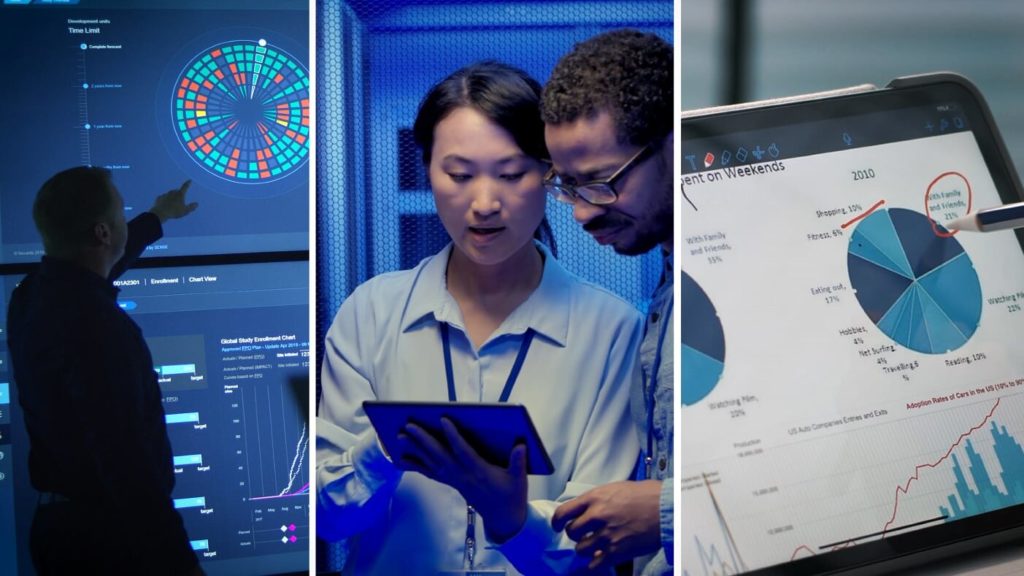Put AI into action and empower everyone in your organization
New circumstances require that we find new ways of doing things. Because of the current global health crisis, I had to do something I’ve never done before: deliver a full keynote from a spare, upstairs bedroom in my house. It occurred to me that a fitting start to my speech would be to welcome everyone to my home!
I have to say it was quite a different experience speaking to an audience of industry leaders without having actual people in the room. I love the energy that flows from connecting with live audiences – although I have to say the unconditional acceptance from my dog Buddy, who attended from start to finish, was a welcome morale boost! The keynote I gave, “Building an AI-Powered Organization,” was a part of today’s Imagining the Future virtual summit about AI.

Circumstances in the world over the past few months have forced all of us to try things we’ve never done before. Life and business, as we know it, have been disrupted. Now is the time to think through how we can innovate and transform our way of doing business going forward. The next 12 to 18 months will be a critical defining period for many businesses, and artificial intelligence will most certainly will be a catalyst.
Right now, helping your business survive may be top of mind, as you focus on process optimization, cost efficiencies, safeguarding your customer base and mitigating risk. AI technologies available today can bolster your efforts in each of these areas. Yet, as you work to find your organization’s new normal amid economic uncertainty, you have the potential to redefine your business – and to transform your organization’s potential.
To transform is to embrace the potential of “what if.” As you respond to the challenges your business is now facing, let yourself also reimagine what’s possible. Consider how you can tailor innovation to your organization’s unique value – and how incorporating AI into your solutions and your strategy can enable every person in your organization to use technology in meaningful and relevant ways.
Solving today’s problems
Starting right now, you can find and cultivate market-making opportunities that will help you overcome today’s tremendous disruption and challenges, setting you on a path toward becoming an AI-powered organization. Through our work with customers, we have seen many ways in which AI can make a meaningful impact. We see it as particularly useful at this time in three key areas:
The integration of AI technologies can help optimize business processes, which can find efficiencies, reduce costs and ultimately generate new revenue. That’s what it did for Piramal Glass, which used AI models for real-time monitoring and insights to detect product anomalies and defects, ultimately improving production efficiency and product quality.
AI can help empower employees and increase productivity by reducing the time spent on repetitive tasks, as well as facilitating machine teaching and reinforcement learning. In early trials with Microsoft autonomous systems solution Project Bonsai, National Oilwell Varco (NOV) reduced machine downtime and costs. Experienced machinists trained industrial control systems using machine teaching, optimizing the workflow – and the time – of both experienced machinists and less-skilled operators.
And AI tools can improve customer service with end-to-end customer management, proper lead routing and triage and real-time behavior prediction and data monitoring. Australian Red Cross began work early this year on a system to connect volunteers with vulnerable individuals, and was able to quickly shift focus to connect volunteers with individuals who are self-isolating during the COVID-19 pandemic.
As the Red Cross example shows, the potential for AI is particularly relevant now in healthcare. Business process optimization can help ensure critical medical supplies are available where they’re needed and when, and tools to increase productivity mean healthcare workers and researchers can augment their expertise to help them solve the biggest challenges of this pandemic while they make the most efficient use of their time and skills.
In customer service, Microsoft’s Healthcare Bot service has been used by public service and health organizations on the frontlines of the COVID-19 response, reaching more than 39 million people.
I am impressed by the agility and speed with which so many organizations have risen to the current challenges and have adapted their existing business practices to accommodate new requirements. It’s fascinating to see how technology has been fundamental to the changes and ways they are innovating to meet the needs of doing business differently today.
Consider how you can tailor innovation to your organization’s unique value – and how incorporating AI into your solutions and your strategy can enable every person in your organization to use technology in meaningful and relevant ways.
Exploring what’s possible
Right now, you may be examining your business strategies and revising plans for the near and distant future. And as we gradually overcome this crisis, there will undoubtedly be a new normal.
This new normal may require you to examine your business model and to redefine who you are as a company, how you approach problems and how you make decisions. It is an opportunity to think big and be bold – and AI can help. Here are three key considerations as you consider whether and how to become an AI-powered organization:
Scaling AI. To be successful, AI must be woven into the very fabric of your entire organization. AI can have the most impact and make the biggest difference when it is part of your culture and strategy, and when your company’s technological capabilities and desired business outcomes are considered side by side.
Driving AI culture and strategy to move beyond pilot and proof of concept requires the right approach from business leaders. That’s why, more than a year ago, we launched AI Business School, a free online master class series designed to set you up for success. More than a million people have accessed the resources there, and I’m happy to share today that we have added two new modules:
My team and I have had many detailed conversations with AI experts and executives across the world that informed all of the modules, and we will continue to add to the content as we learn more from them about what businesses need for their AI journeys.
To bring AI culture to life, companies are bringing technology and business together into a combined lifecycle driven by business outcomes. This model, which is familiar within software development as DevOps, is making its way into AI development with its counterpart, MLOps. MLOps, known to many as machine learning and operations, can improve business results and accelerate time to market by centrally managing models, environments, code and datasets so they can be shared among data scientists, ML engineers, software developers and other IT teams through the entire ML lifecycle.
In Vancouver, BC, transit agency TransLink deployed 18,000 AI models to better predict bus departure times, accounting for factors including traffic, weather and other disruptions. The agency used MLOps with Azure Machine Learning to manage and deliver the models at such a massive scale that they were able to improve their prediction accuracy by 74% and reduce customer wait times by 50%.
AI for everyone. To fully benefit from AI, each of your employees must feel empowered and included. A recent survey of 10,000 employers and employees found that 91% of employees want new skills that will help them succeed alongside AI. Employees of companies that have integrated AI companywide report that they find more meaning in their work and want to use AI more.
Many of your employees may already be using AI tools in their daily work. AI is incorporated into applications in Microsoft 365 to encourage teamwork, facilitate productivity and improve decision making. And your employees in sales, marketing and customer service may be using solutions in Dynamics 365 AI to improve performance across those departments. In Power Platform, AI Builder gives everyone in your organization the ability to add AI capabilities to the apps they create and use – without any technical experience.

Your organization’s data scientists and developers can use Azure AI services to create custom AI models and applications to solve the unique challenges you face.
One scenario I’m particularly passionate about is the ability for AI to empower subject matter experts. AI for Reasoning enables experts and researchers to choose which AI model to employ to analyze information and easily share it with peers.
Swedish whisky maker Mackmyra recently won a silver cube product design award for creating the world’s first machine-generated whisky. The company’s master blenders fed a machine learning model existing recipes, sales data and customer preferences, and the machine made quick work of generating high-quality recipes that would prove popular.
Swiss pharmaceutical company Novartis used AI to redefine its business functions across the organization, empowering every individual to apply AI models to augment their expertise and creativity without needing to learn data science. AI brought together mass amounts of critical information across data sources and streamlined collaboration.
Now, 50,000-plus employees can quickly make sense of the vast amount of data they deal with, deriving insights that will help them transform how medicines are discovered, manufactured and commercialized.
Responsible AI. As you put AI into action, particularly in these times of change, it’s imperative to consider the implications of technology. AI must be integrated in a way that aligns with your company’s values, goals and priorities. Companies that incorporate AI successfully implement practices from the beginning to guard against potential misuse of AI, such as biased or unfair results.
At Microsoft, we’ve been on our own AI journey for some time, and we are committed to sharing key learnings and are doing so both through the Responsible AI module within our AI Business School as well as the Responsible AI Resource Center, which is perfect for technical teams developing and deploying AI.
How can we help?
We know you’ve got a tremendous amount on your plate right now. Considering how you adjust to the changes we’re all experiencing, while continuing to serve your customers and support your employees, is an extremely tall order. As difficult as the current challenges are, we believe the implementation of short-term solutions and a focus on strategic, long-term planning go hand in hand as you transform your company into an AI-powered organization. Now is a perfect time to think of the possibilities. Good ideas coupled with perseverance will go a long way toward helping you respond to today’s challenges and imagine a better tomorrow. We’re excited to help you as you make progress on your AI journey. Visit AI Business School to help you get started putting AI into action. I promise, you’ll be glad you did.
Download the AI in Action white paper to read more on Microsoft’s perspective and how we are making AI real for businesses today.








